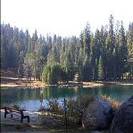Sequoia was named in honor of the Cherokee Chief Sequoya. Chief Sequoya had most likely never seen a giant Sequoia tree, however, this intelligent chief who was a silversmith and U.S. army soldier, as well as the inventor of the Cherokee written language, was given the honor of having this magnificent and timeless tree name after him.
The giant Sequoia, found in Sequoia and Kings Canyon, is also called "Sierra Redwood" and the "Big Tree." The Sequoia has a column-like trunk, stout branches, and fibrous, reddish-brown bark. This stately evergreen is one of the oldest living trees on earth. Because of ideal growing conditions -- mild, wet winters and dry, warm summers, it is one of the fastest-growing trees, eventually reaching 270 feet or more in height. The ropy bark of the Sequoia, sometimes two feet thick, is the tree's main defense against bugs and bacteria that could kill it. Its dense coat is virtually impervious to brush fires and insect invasions. Giant Sequoias grow naturally only on the west slope of the Sierra Nevada. You will find them in 75 separate locations, including 30 groves in Sequoia and Kings Canyon and 3 in Yosemite. Sequoia National Forest and a few other isolated spots also have Sequoia. Of the world's 37 largest Sequoia trees, 20 are giant sequoias growing in Sequoia and Kings Canyon.
Towering Sequoias dwarf the landscape. As you progress along the Congress Trail, a two-mile loop, you will encounter the General Sherman Tree, which is hailed as the largest tree (by volume) in the entire world.
SEQUOIA FACTS
- Height: Up to 311 feet
- Age: Up to 3,200 years
- Weight: Up to 2.7 million lbs.
- Bark: Up to 31 in. thick
- Branches: Up to 8 ft. diameter
- Base: 40 ft. diameter
- Reproduce: By seed only
- Seed Size: As large as oat flakes
- Cone: Shaped like a chicken's egg
- Foliage: Small, overlapping, awl-shaped needles









